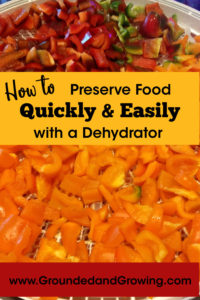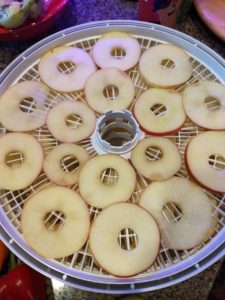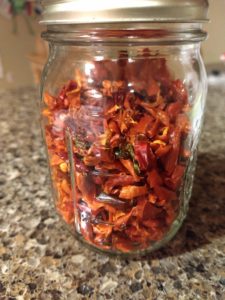 Using a dehydrator to preserve food is a lot quicker and easier than you think. Plus the final products can be stored right in your pantry.
Using a dehydrator to preserve food is a lot quicker and easier than you think. Plus the final products can be stored right in your pantry.
This post contains affiliate links for your shopping convenience.
I grew up in a family that had a large vegetable garden, and my mom canned a lot of the produce to preserve it. Mostly what she canned was whole tomatoes or something tomato-based– a mix of tomatoes, zucchini and green beans with a touch of Italian herbs was a popular concoction.
But I never did like eating those canned tomatoes. I loved helping my mom can tomatoes– something about scalding the fresh tomatoes in boiling water and plunging them into ice-cold water to slip their skins off is still strangely satisfying to me today!
As I got to be in high school, I started making my own jam with raspberries from our garden. My life to that point had been filled with endless jars of concord grape jam I remember my grandma making. So it was a bit of a rebellion to make raspberry jam.
Over time, my mom has canned less and less. I honestly can’t remember the last time I saw her can anything. She pretty much freezes what she preserves from the garden these days.
The last time I canned anything was some Tomato Jam back in 2016. It’s just such a PRODUCTION to get all the canning equipment out. And you might as well forget doing anything else that day.
I also freeze most of what I harvest from our garden. But a few years ago (B.C.– before children!) I got curious about dehydrating, or drying food to preserve it. A couple of friends told me how much they used their dehydrators, and the things they made.
Food dehydrator = Easy Food Preservation
I bought a fairly inexpensive, entry-level dehydrator, and it opened a whole new world of food preservation. Here are some of the things I’ve learned, and some tips that will get you started with dehydrating today:
- Prepping food for dehydrating takes a lot less time than canning or freezing. Once you get the food sliced or otherwise prepared, the dehydrator does the work for you. You just have to keep an eye on how dry the food gets.
- Dehydrating can increase fruit and vegetable consumption in your household. I can’t keep up with the demand for homemade apple chips in our house.
- Dried foods are shelf-stable. I found a new appreciation for this when our deep-freezer died a few years ago. It’s nice to have a freezer full of garden veggies, but if that freezer goes down you’re in trouble. Like canned food, dried foods can stay on the shelf with no refrigeration for years. Now if you don’t eat them within a reasonable timeframe they may not taste as good, but they will still be safe to eat.

Place cored and sliced apples in a single layer on the dehydrator tray for best results.
- My two favorite foods to dehydrate that require very little preparation are: apples and green or colored sweet bell peppers. Store each of these in their own air-tight container, such as a mason jar.
- Apples: Wash, then remove the core (this is my favorite tool that saves a ton of time) and thinly slice. Place in a single layer on dehydrator trays and dry until crisp at 135°F.
- Green or colored sweet peppers: Wash, then dice peppers as you would for your favorite recipes. Place in single layer on dehydrator trays with fine mesh insert and dry until completely dry at 135°F.
- There are a lot of very expensive food dehydrators on the market. I’ve had great luck with the relatively inexpensive model listed below. The two books and website listed are the first resources I consult when looking for ideas.
My Favorite Resources
Nesco Snackmaster Pro Food Dehydrator— I have an older version of this model, but it’s still the same round stacking trays. I bought extra trays to expand my dehydrator to it’s maximum capacity of 12 trays. I also bought these fine mesh inserts which are great for keeping smaller items like chopped peppers from falling through the trays as they dry. The fruit roll trays are also handy to have around.
Mary Bell’s Complete Dehydrator Cookbook— This is an all-around wonderful resource to have on hand for information on dehydrating just about any food. I use this book in combination with the National Center for Home Food Preservation website for figuring out any questions I have on dehydrating.
Food Drying with an Attitude— Another book from Mary Bell; this one is a bit more specialized with recipes for dehydrated snacks, meals, and crafts (rather than just individual food items).
Apple Corer— I’m lucky I didn’t slice a finger off trying to core a bag of apples with a knife. After seeing how much my family loved apple chips I decided an apple corer was cheap insurance for keeping my fingers intact.
National Center for Home Food Preservation— This is THE source for up-to-date information about home food preservation. If in doubt about recipes you get from a friend or find online, this is the best place to compare for reference. There are tons of free, tested recipes for not only dehydrating but also canning and freezing. There is also a link to purchase University of Georgia’s book “So Easy to Preserve” which is nice to have on hand (most of the information is available for free on this website).
I hope you’ll take this post as inspiration and encouragement to try food dehydating for yourself. I really think its the unsung hero of food preservation and is really a method that fits well with our busy modern lives.
If you’re short on time and garden space, check out how I grow tomatoes in containers at my house— you can grow other vegetables in containers too. If you are wanting to experiment with growing vegetables indoors, check out the Aerogarden. I’ve been growing tomatoes for the last year in mine.

Store dehydrated bell peppers in an airtight jar; Mason jars are a great choice.
If you liked this post, please subscribe to Grounded and Growing today and receive your copy of “15 Tips to Become a '15 Minute Gardener'” so you can spend less time working ON your garden and more time enjoying being IN your garden.! It’s absolutely free. When you join the Grounded and Growing community, you’ll finally take the garden off your “To-Do” list and allow yourself time to enjoy your garden and savor the peace and serenity there. I tell subscribers about new posts as soon as I hit ‘publish’ and send weekly-ish updates on what’s going on in my garden– good, bad AND ugly.

All Rights Reserved. © 2019 Jennifer Schultz Nelson.
Good luck! I really enjoy your posts and have been wondering if you’re going to be the host for “Mid-American Gardener? You do an excellent job on hosting.
Thank you so much! I was just filling in as host on Mid-American Gardener while the Tinisha, the regular host, was out on medical leave. But I do appreciate your compliment! It’s great to know that more than just my family likes it when I host!